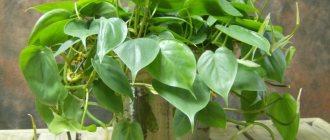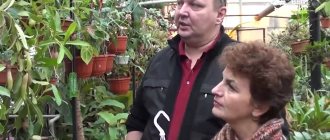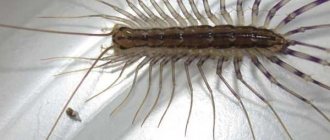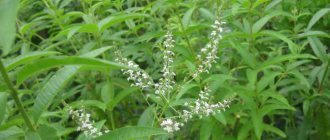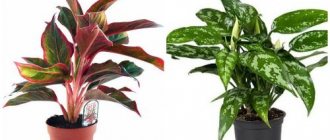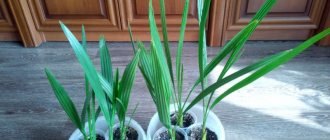We all love to keep indoor flowers at home. Many of them need the sun to grow and develop. But the southern window sill is not enough for everyone. In this case, you should turn your attention to shade-loving and shade-tolerant indoor plants. These flowers can do well with a minimum of sunlight, which makes them welcome guests in any home.
Dear readers! For you, we have created communities on social networks in which useful articles and interesting ideas are published several times a day! Subscribe and receive useful content in a convenient format!
What plants are considered shade-loving?
First of all, it is necessary to clarify that there are shade-tolerant plants, and there are shade-loving ones.
The first group includes flowers that feel equally good both in the light and when there is a lack of sunlight. The difference in lighting has virtually no effect on their appearance, abundance and duration of flowering.
The second group includes plants that are contraindicated in bright and direct sunlight and prolonged exposure to the sun. This group has 2 more names - sciophytes and heliophobes. That is, plants that are afraid of the sun.
Bright light is harmful to them, and prolonged exposure to the south side is fraught with overheating of the leaf plates and sunburn.
Among the plants that prefer dark corners there are both decorative flowering (begonias, violets, anthurium, clivia, cyclamen, fuchsia, etc.) and decorative deciduous (chlorophytum, sansevieria, aspidistra, aglaonema, philodendron) species. Also, some types of palm trees and other large plants with large leaves or long stems (dracaena, cordyline, monstera, etc.) do not like the sun.
Large species and palms
Unpretentious indoor plants of this type:
- Dracaena is an indoor tree. In order for it to maintain an even stem, you should turn the pot a quarter turn from time to time. You can place it no further than two meters from the window. She likes the proximity of other plants, she receives the necessary moisture from them;
- fatshedera is a hybrid of common ivy and Japanese fatsia. It can even be placed near the north window. In the warm season, the flower will like the fresh air, in the shade. The cause of leaf falling may be excess moisture; support from moss will help successful development;
- chamedorea is a thin-trunked bush-like palm tree, growing from 40 cm to 1 meter. In the house you can place it near the north or east window. To achieve a decorative effect, it is better to plant several specimens in one pot;
- Monstera is an unpretentious tropical vine. Huge leaves are up to a meter in diameter, the flower itself can reach 2-3 m in height and 1.5 m in width. For good growth, you need support, bright diffused light or partial shade. In summer we water on average once a week, in winter less often. Likes to be sprayed;
- Ficus rubber is a large plant with dense and shiny leaves. Feels good at a distance of 2-3 meters from the light source. More often suffers from excess moisture than from its lack. Water once in winter, and twice a week in summer. To make the ficus branch better, the tops of young plants are cut off.
Large flowers for dark rooms such as the hallway or living room, which need a lot of space to grow and develop:
- Schefflera is a branched shrub with flexible branches. The plant tolerates shade well, but feels better if the sun hits the fleshy patterned leaves with its rays for several hours a day. The tips of the branches of a young flower can be pinched for better branching. Under favorable conditions, Schefflera turns into a powerful home tree;
- Philodendron is a large tree-like plant; many green flower species tolerate shade well. Water once a week, in winter in a cool place - once every 10-12 days. A daily spray of warm water will please this vigorous vine. In the house it can grow up to 3 meters. You can trim branches that are in the way;
- Fatsia is a lush shrub that eventually forms a small trunk. In a pot it grows up to two meters and can grow in partial shade. Will appreciate wintering in a cool room at a temperature of at least 10°C;
- Rapis is a bamboo-like fan palm that grows up to two meters in a pot. Needs a place protected from direct sunlight; in summer it can be placed in the garden under the shade of trees. Likes to grow in a cramped pot. If the tips of the rapeseed leaves turn brown, the flower is most likely not getting enough light or too much water.
Shade-loving indoor plants for the hallway
For the hallway it is better to choose decorative foliage plants. If the size of the room allows, you can pay attention to palm trees and false palms, as well as specimens with large spreading leaves.
Monstera
A distinctive feature of Monstera is its large carved leaves that grow on long, dense petioles. Monstera is able to amaze your guests right from the door. It adapts well to room conditions, and using supports you can create a beautiful flower arrangement.
ATTENTION! Monstera is considered a vampire plant, and it is not recommended to place it in the bedroom.
Ivy
This is a whole group of hanging plants and vines. These include Philodendron, Tetrastigma and Syngonium. The advantage of ivy and vines is that they do not take up useful space in the room. They can be placed on cabinets and shelves, or hung on the walls. In the cramped conditions of Russian apartments, this is an important quality. The advantages of ivy include their ease of care. They grow well without regular exposure to sunlight.
Ficus
Ficus is a plant that does not really like sunlight and tolerates the coolness of the hallway well. It is better to choose tree-like varieties. The advantage of ficus trees, in addition to their unpretentiousness, is their high decorative value. The flower lends itself well to shaping. At the same time, you can give the appearance not only to the crown, but also to the trunks and stems of the ficus.
Rapis
It is highly decorative. Loves frequent watering. The advantage of Rapis is its slow growth. That is, this palm tree will rarely have to be replanted. Rapis has unusual oval leaves. This plant is suitable for wide halls, hallways, and verandas.
Ferns
This group includes Pteris, Platicerum, Pellea, Venus Volos, Blekhnum, Davallia and many other plants. Ferns tolerate the absence of light well, since in nature they live in the lowest tiers of tropical forests. They love moisture, but are otherwise extremely picky plants.
ON A NOTE. It is not recommended to place ferns in places where people are constantly present: living rooms, bedrooms, kitchens.
Shade-tolerant vines and ampels
Climbing, shade-loving and shade-tolerant plants look very attractive in hanging baskets, planters and baskets. Asparagus pleases with its bright openwork foliage, chlorophytum cheerfully produces “babies”, striped zebrins flash.
Assortment of hanging plants for dark rooms:
- Tradescantia;
- plectranthus;
- chlorophytums;
- asparagus;
- ivies.
This group of plants is suitable for rooms with artificial lighting and northern windows. When choosing hanging types, pay attention to the general pattern. Indoor flowers with monochrome leaves are more shade-tolerant than variegated ones.
Common indoor ivy
A house flower with leathery green leaves can be grown in the bathroom. It should be taken into account that a lot of water evaporates during showering and bathing. Therefore, the humidity in the room is higher than in other rooms.
Ivy loves warmth and moisture, tolerates shading, and adapts to artificial lighting. Hanging, densely leafy shoots look great on high shelves or in hanging plant pots.
Syngonium
Species of the genus Syngonium are distributed in the tropics and subtropics of America. These are large vines, usually growing as one long shoot. Modern hybrids differ in their type of growth - they are more compact, in the form of bushes or ampels.
Syngonium with monochromatic green leaves is more shade-tolerant. Variegated varieties are partially shade-tolerant.
Philodendron
The green climbing plant has heart-shaped leaves and tolerates low light in the corners of the room. Partial shade on a wall next to or opposite a window is an ideal place for a philodendron.
Philodendron can be grown in the kitchen, bathroom. Leaves purify and disinfect the air, trap gases that are released when burning gas or coal.
Asparagus
Most asparagus species prefer diffused light and cannot tolerate direct rays. They are highly decorative due to their delicate greenery and creeping shoots. It is convenient to grow asparagus in hanging baskets, attaching them to the wall.
Considering that in the autumn-winter period the flower needs rare watering, placing it on the wall does not cause any special problems.
Flowering shade-loving plants
There are not many flowering shade-loving plants, but they do exist. Basically, a flower (or inflorescence) only complements the beauty of the leaves, emphasizing their unusualness.
But there are also specimens that are valued specifically for their flowers. For example, fuchsia, cyclamen, begonia.
Calathea Crocata
Calathea Crocata is considered shade-tolerant. This is a very beautiful plant, capable of growing up to 0.7 - 0.8 m. It has large beautiful leaves. The leaf blade is colored green (upper part) and dark burgundy (lower part). In addition to beautiful leaves, Calathea boasts inflorescences. Small flowers form spikelets of various shades. Calathea is quite capricious in care; it requires air humidity, temperature and regular spraying.
Cyclamen
The plant is known primarily for its tilted flowers with bright, but at the same time delicate coloring of the petals. But the leaves of Cyclamen are no less beautiful. They can be variegated or plain. Cyclamen does not like direct light, but the setting sun will not harm it, so it can be placed on a western window.
Anthurium
The handsome Anthurium is distinguished by both its flowering and foliage. The plant has a small spike-shaped inflorescence, which is located on the spathe. This particular leaf differs from the rest in its color and shape. The leaves of the flower are no less attractive. They are glossy, dark green, with a pointed tip.
Begonia
Begonia prefers partial shade, but it is not advisable to place it in bright sun. The ideal place for it is an east or west window. Begonia tolerates the lack of light, but may lose its decorative value. The flower loves high humidity, but not spraying. Despite the fact that Begonia is valued for its leaves of different shades, it blooms quite beautifully. Among the varieties there are erect and hanging specimens. Begonia is easy to care for and reproduces well.
Vriesia
Vriesia is very decorative. It is especially valued for the color of its rosette leaves, which are mistaken for the inflorescence. They can be red, white, pink and yellow. Suitable for decorating shelves, bedside tables, and display cases. Looks elegant in flower arrangements. The advantage of Vriesia is its shade tolerance. It grows well in both light and shade. Feels good on east and west windows.
Miltonia
Pansies from the world of orchids. Despite the fact that Miltonia prefers diffused light, it also feels good on the north side. It blooms with very beautiful variegated flowers. Loves high humidity and warmth. Quite demanding to care for, like any orchid. Likes to get sick from drafts or dry air. Miltonia is not recommended to be placed in bedrooms. She will feel best in the living room, hallway or office.
Loving shade and living in an aquarium
High humidity and lack of light are not the most pleasant conditions for most plants. The exception is a small group of species that live on the banks of water bodies or half in the water.
Caladium
The plant is valued for the beauty of its leaves - plain and variegated, combining shades of green, white, yellow, and purple. The tuber overwinters in the soil, the above-ground part “falls asleep.” Beautiful leaves appear in the spring and last only until early autumn. In this case, the plant requires high humidity, heat and diffused light.
Caladium is placed in partial shade, preferably in moist peat. The plant is moisture-loving, so it feels good in the bathroom.
Cryptanthus
A flower with a luxurious rosette of brightly colored leaves is not easy to grow, like all Bromeliads. Although some people think that Cryptanthus is similar to Sansevieria, some of its species have the same expressive stripes on the leaf blades. However, bromeliads are more demanding of location and humidity and grow better in greenhouses and florariums.
The flower requires shady or artificially lit locations. The wide, star-shaped, colorful rosettes are the most shade-loving of all bromeliads.
Siderasis brownish
Another plant with leaves collected in a rosette, distinguished by silver stripes on a dark green background and brown hairiness. In nature, siderasis grows in shady, moist forests and craves the same atmosphere in indoor conditions.
It is better to keep it in an aquarium or florarium with high walls, where you can create a wet greenhouse.
Cyperus
The marsh plant Cyperus is tolerant of light. The main thing for him is high humidity. This is an unpretentious indoor flower that is ready to adapt to a small amount of light.
Cyperus grows well in artificial light, which allows it to be placed in a hallway or bathroom, in a tray of water or an aquarium.
Unpretentious shade-loving flowers for apartments and houses
When purchasing sciophytes, we mainly want to get a plant that will not need to be constantly looked after and that requires minimal care. Basically, such copies are purchased for public spaces: offices, anti-cafes, reception areas, etc.
ON A NOTE. Unpretentious heliophobes are not so decorative, but are quite capable of decorating a room.
Crassula (money tree)
The money tree grows well on the north side. It is unpretentious and easy to grow. The main disadvantage of the plant is its size. If growth is not limited, the money tree can grow into a large bush. Then caring for it will be quite difficult. But small specimens are perfect for almost any room.
Chlorophytum
This is a true indoor plant classic. Long, narrow, slightly curling leaves, a bright green hue - chlorophytum is familiar to almost every resident of the post-Soviet space. Chlorophytum does not bloom and is excellent for landscaping public spaces and formal premises. The flower does not require special care.
Scindapsus
A beautiful creeping vine with mottled leaf blades. The leaves are medium sized and very neat. Variegated varieties require more sun, so for growing in the back of the room or in a dimly lit room, mainly varieties with uniformly colored foliage are suitable. It is considered a shade-tolerant plant.
Hedera
This ivy grows quickly. It has interesting star-shaped leaves that look like grapes from afar. This is a very persistent vine. Hedera is able to stoically endure not only the lack of sunlight, but also temperature changes and long droughts. Disadvantage - Hedera is not very decorative and is inferior in beauty to many flowers from this list.
Which ones to put in the hallway?
The hallway is the most difficult room from the point of view of phytodesign. There is no natural light here at all; drafts are possible.
However, many people want the corridor to look cozy and please the eye with beautiful flowers. Therefore, in the plant kingdom there are real Spartans who can adapt to difficult conditions.
These include:
- chlorophytum;
- Sansevieria;
- fern;
- ivy;
- Tradescantia.
When placing potted plants in the hallway, you need to try to make their life easier. To do this, you can install special lamps and leave them on throughout the day.
Flowers located in the corridor need to be fed less frequently so as not to provoke sudden growth. Otherwise, there is a risk of getting large but ugly plants with a bare trunk and small, sparse leaves.
If the flower sent to the hallway has noticeably weakened, began to shed its leaves or lose its beautiful color, you can give it a vacation. For several days it is moved closer to a source of natural light, allowing it to gain strength.
Shade-loving plants with decorative leaves
Heliophobes are mainly valued for their beautiful and unusual leaves. They have different shapes and shades. Among the decorative ones, you can choose a copy for the bedroom, and for the hallway, and for the study.
Maranta
Just 15-20 years ago it was one of the most common indoor plants. But then the fashion for Maranta passed, and now it is much less common. But this flower has very beautiful, variegated leaves with different colors. There are specimens with almost black shades on the leaf blades. Arrowroot is a small bush and it will easily fit into any interior. The disadvantage of the flower is its capriciousness in care and constant requirements for spraying.
Tradescantia
A distinctive feature of Tradescantia is its striped, tucked leaves that grow on dense, geniculate stems. In general, it is quite easy to care for, and if you know a few tricks (for example, pinching), you can form a lush and beautiful bush. Different varieties have different colors from each other, which allows you to choose a copy for any interior.
Fittonia
Although Fittonia blooms, it is valued primarily for its unusual leaves. The leaf blades are speckled with different shades (green, red, brown, purple), which are combined in different variations. Fittonia is considered a shade-tolerant plant, and there is no need to leave it completely without light. But on an eastern or western windowsill it will feel great.
Aglaonema
There are two groups of Aglaonema - with variegated leaves and with leaf blades of solid color. A flower with variegated leaves needs light, but varieties with a single color grow well in the shade. Aglaonema leaves, in addition to their decorative properties, also have quite healing properties. They purify the air in your apartment from chemical compounds emitted by household chemicals, furniture, objects, etc.
Aucuba
A fruiting flower with variegated leaves with a carved edge. Mostly Japanese varieties of Aucuba are grown. Of particular value are the leaves that appear to be stained with paint. Aucuba can be placed in the back of the room or on the east window. Loves spraying and watering.
What is special about shade-tolerant house flowers?
Heliophobic plants can be distinguished from sun lovers by their appearance. Signs of shade tolerance are:
- large soft smooth leaves;
- thin epidermis - the top layer or skin on leaves and trunks;
- the leaves are arranged horizontally.
This structure is the result of adaptation to difficult conditions. Thanks to it, plants capture more scattered light.
Interesting! Some shade-loving plants, when in well-lit places, change the color of their leaves from green to reddish or purple.
The process of photosynthesis was also transformed under the weight of circumstances. It began to pass much less intensely. Thanks to these changes, flowers thrive in the shade, allowing you to brighten up the dullest spaces.
Which shade-tolerant plants are suitable for the bedroom?
You need to carefully select plants for the bedroom. Here a person rests, and plants should not disturb him. There is a category of vampire plants that have a depressing effect on humans. But there is another category, which includes those representatives of the flora that purify the air and have a sedative effect on the central nervous system.
Sansevieria
This is an ornamental deciduous plant with long erect leaves. It has different colors of leaf plates. Sansevieria looks very impressive and is perfect for decorating a bedroom. A special feature of Sansevieria is that it produces the greatest amount of oxygen in the dark. In addition, the plant neutralizes the effects of many harmful substances and bacteria.
Violet (Saintpaulia)
Uzambara violets have long become familiar guests in houses and apartments. The beauty of violets is that they grow well and do not lose their decorative value on a north window. And the abundance of varieties and hybrids allows you to choose Saintpaulia to suit your taste. Also, violets can be grown without any access to the sun at all, but then you will have to organize illumination with phytolamps. Which, however, is not entirely suitable for the bedroom.
Spathiphyllum
Women's happiness is an excellent choice for the bedroom. The flower stands out not only for its beautiful decorative leaves with a glossy tint, but also for its unusual flowering. A small inflorescence of a cob appears on a snow-white blanket. In addition to its decorative function, Spathiphyllum is also a useful plant. It produces oxygen, suppresses allergens and harmful chemical compounds.
Hamedorea
Hamedorea is an excellent choice for a city apartment. The plant humidifies the air and at the same time absorbs harmful substances. Another advantage of this palm tree is that it actively produces ozone, which allows you to wake up rested and refreshed. The disadvantage of Hamedorea is its size. A tub with this palm tree may not always fit in the bedroom, but while the tree is small, it can be placed in a corner not far from the bed.
Dracaena
The dragon's tail will take root perfectly in the corner of the bedroom. Dracaena produces large amounts of oxygen and simultaneously absorbs many harmful substances, including formaldehyde. The advantage of dracaena is its decorative effect. If you carefully care for the plant, regularly prune and replant, you can form an amazing tree that will become a real decoration for your bedroom.
IMPORTANT! These are just some of the heliophobes that can be grown at home. In fact, there are much more of them. Here we have presented the most interesting and beautiful, in our opinion.
How to choose lighting for shade lovers
Despite the fact that shade-loving flowers are afraid of direct sunlight, this does not mean that they do not need light at all. They just need less of it and use a different part of the light spectrum.
For heliophobic flowers, 1000 – 2000 lux is considered optimal.
The best option would be fluorescent and LED lamps. Their spectrum is most suitable for plants and will promote their growing season almost identically to natural conditions.
ON A NOTE. You can also use phytolamps, but they emit violet light, which often causes discomfort to the human eye.
The height of the lamps must be selected individually, but remember that you cannot hang them too low, as there is a high probability of burning the sheet plates. Also use reflectors to diffuse the light. This will also help you save some money. You can buy a reflector or make it yourself from food foil or white material (paper, fabric).
Features of care and cultivation
Each specific species has its own requirements for care and growing conditions, but we can formulate the basic principles of growing shade-loving flowers at home.
- Plants should be kept in shade or partial shade. The best place for them is in the back of the room, as well as on the north and west windows.
- The sun has a detrimental effect on the growth, development, flowering and color of leaf blades. The foliage is not adapted to dissipate heat, so prolonged exposure to the sun can cause a burn.
- Temperature and humidity requirements must be observed. Watering is equally important. Under natural conditions, most of the shade-loving flora lives in the lower tiers of tropical forests, in the shade of trees. It's quite damp and warm there. Similar conditions need to be recreated at home.
- Watering is no less important. Most heliophobes like regular, abundant watering. The water should be warm and settled, as hard water straight from the tap will harm the plants.
- Such plants do not like frequent transplanting and moving from place to place.
- The foliage must be regularly wiped from dust and sprayed.
- It is also very important to control the emergence of pests and fungal diseases.
- To preserve the decorative qualities of plants, you need to carry out regular fertilizing. Now stores sell specialized fertilizers for decorative deciduous and decorative flowering plants. It is better to use them, since these preparations have the best concentration of active ingredients.
Plants that grow well in the shade
Not only indoor flowers do without a lot of light. Vegetable crops that are cultivated for food also thrive in the same conditions.
Some of them are suitable for growing on kitchen window sills and balconies facing north. This experiment will survive:
- lettuce leaves;
- spinach;
- dill;
- parsley;
- celery;
- tomatoes of “polar” varieties;
- beans.
A vegetable garden on the windowsill will not take much time and effort. Even if it is located in the shade. But the benefits of such a “bed” are obvious.
Answers to frequently asked questions
Do flowers need additional lighting?
Not always. It all depends on the plant and its location. If you place the pot on a north or west window, then additional light is not needed. If the room has no windows, then lamps are needed for additional illumination.
Is it possible to put vampire plants in the bedroom?
No direct effect of plant energy on humans has been found, but vampire plants release special substances at night that have a bad effect on the human nervous system, so it is better to place such flowers in the living room.
How often should shade-loving plants be replanted?
Almost the same as everyone else. When a flower outgrows its pot.
What plants to put in a child's bedroom?
A good choice is 1-2 violets and a couple of Sansevieria specimens. In any case, place the flowers so that children cannot reach them and taste them.
